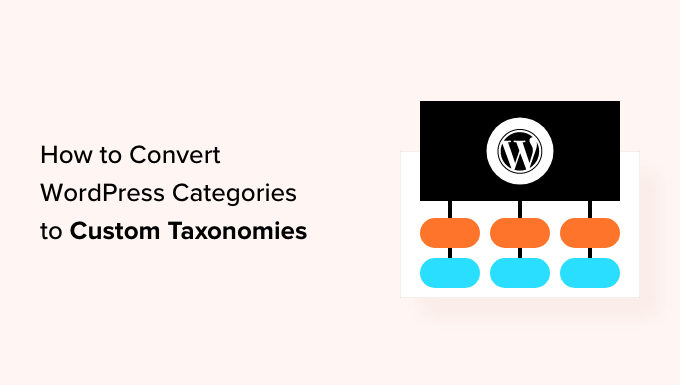Do you need to convert your WordPress classes into customized taxonomies?
Classes are one of many two default taxonomies that assist you to kind your content material. WordPress additionally means that you can create and use customized taxonomies.
On this article, we’ll present you simply convert WordPress classes to customized taxonomies.
Why and When Do You Have to Convert Classes into Customized Taxonomies?
A taxonomy means that you can manage teams of posts and customized publish sorts in your WordPress web site. By default, WordPress comes with two pre-made taxonomies: classes and tags.
Nevertheless, you may also create customized taxonomies with WordPress, which can be utilized with current or customized publish sorts.
As your WordPress weblog grows, you would possibly have to convert your classes right into a customized taxonomy as a result of it may be overwhelming to file and preserve observe of every publish in a class with totally different subcategories.
Utilizing customized taxonomies for tagging permits for extra correct and detailed classifications and higher content material group.
For instance, in case you have a recipe web site, then creating classes for delicacies sort, dietary restrictions, and meal sort generally is a bit complicated.
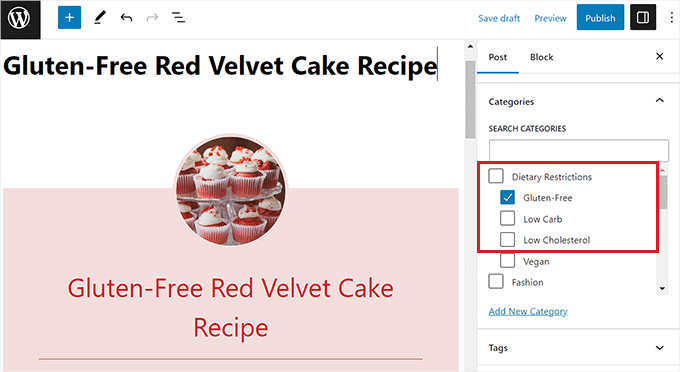
Nevertheless, by making a customized taxonomy for every of those subjects, you may make content material group simpler.
Customized taxonomies may also assist enhance your search engine marketing rankings by providing you with the pliability to make use of extra particular and focused taxonomy phrases.
Having mentioned that, let’s check out how one can simply convert classes into customized taxonomies.
How one can Convert WordPress Classes to Customized Taxonomies
First, you will want to put in and activate the Taxonomy Switcher plugin. For extra detailed directions, you could need to see our step-by-step information on set up a WordPress plugin.
Upon activation, head over to the Instruments » Taxonomy Switcher web page from the WordPress admin sidebar to transform classes to customized taxonomies.
As soon as you’re there, it’s good to choose the ‘Classes’ possibility from the ‘Taxonomy to change from’ dropdown menu.
Which means we will likely be changing a class right into a customized taxonomy.

Subsequent, choose the customized taxonomy that you really want the classes to show into from the ‘Taxonomy to change to’ dropdown menu.
For instance, in case you have a class for dietary restrictions and also you need to swap to a taxonomy of the identical identify, then you may choose the ‘Dietary Restrictions’ possibility from the dropdown menu.
In the event you don’t know create a customized taxonomy, then you could need to see our tutorial on create a customized taxonomy in WordPress.
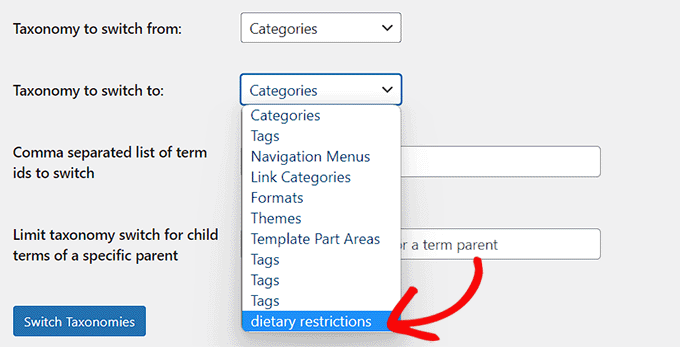
If you wish to convert all of the classes in your WordPress web site into this particular customized taxonomy, then merely click on the ‘Swap Taxonomies’ button.
Nevertheless, if you happen to simply need to convert singular or a number of classes into this taxonomy, then you will want so as to add the IDs of these classes into the ‘Comma separated listing of time period ids to change’ area.
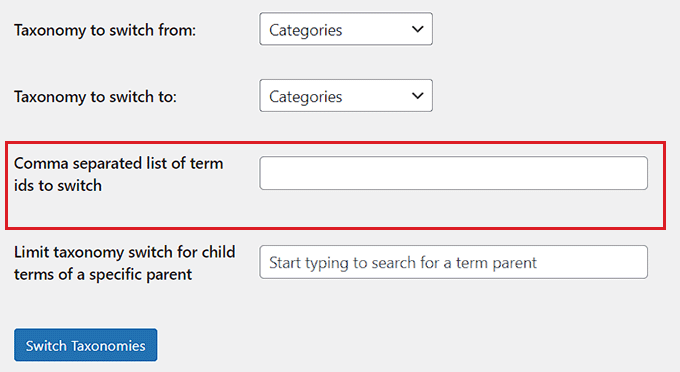
To discover a class id, you will want to go to the Posts » Classes web page from the WordPress dashboard and hover your mouse over the class of your alternative.
The class edit URL will now seem in a popup field on the backside left nook of your display.
From right here, you may simply discover your class ID, as it’s the quantity that comes after ‘class&tag_ID=’ and earlier than ‘&post_type’ within the URL.
For extra directions, see our tutorial on discover class IDs in WordPress.
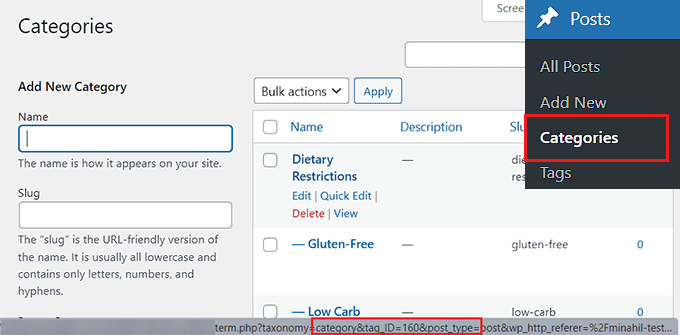
Upon getting discovered the IDs for classes, head again to the ‘Taxonomy Switcher’ web page.
Subsequent, merely add the IDs for all of the classes that you just need to convert into a selected taxonomy. Remember the fact that if you happen to add multiple class ID, then you’ll have to separate them utilizing commas.
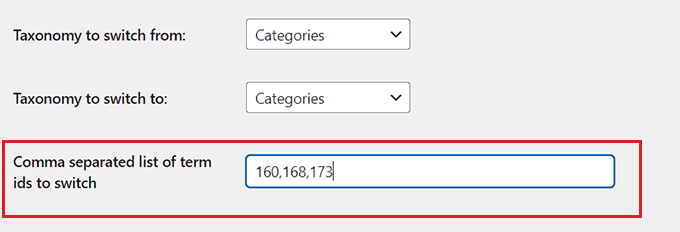
Among the classes in WordPress even have subcategories (little one classes).
Nevertheless, if you wish to skip the kid classes, then you may sort the guardian class subsequent to the ‘Restrict taxonomy swap for little one phrases of a selected guardian’ possibility. This manner, solely the guardian class will likely be switched to a taxonomy.
Lastly, click on the ‘Swap Taxonomy’ button to transform your WordPress class to a customized taxonomy.

You’ll now see the taxonomy that you’ve created together with the default taxonomies within the Posts menu tab within the WordPress sidebar.
Upon clicking on the customized taxonomy, you’ll be taken to a brand new web page, the place you may simply add phrases for the taxonomy by typing in a reputation and slug.

Upon getting finished that, simply click on the ‘Add New’ button on the backside to create a brand new taxonomy time period.
Now go to your WordPress block editor by opening up a brand new or current publish/web page.
Right here, you’ll discover that the class you switched to taxonomy is now displayed within the block panel on the proper nook of the display. From right here, now you can simply add new phrases or use current ones in your WordPress weblog publish.
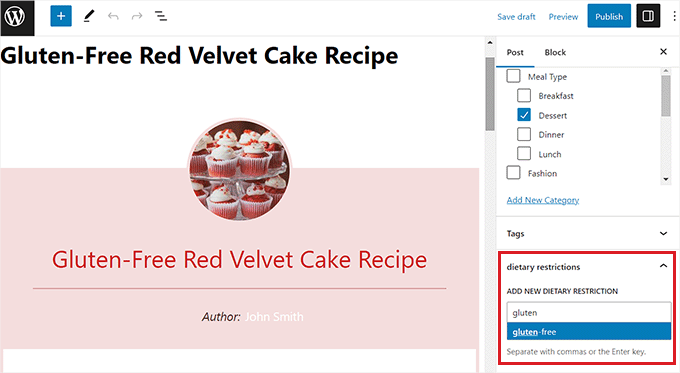
How one can Set Up Redirects From Class to Customized Taxonomy
After you flip one in all your classes right into a customized taxonomy, the class archive web page will now present a 404 error. That is nothing to be fearful about in case your web site is just not reside but.
Nevertheless, in case your web site is reside, then search engines like google and yahoo could have already crawled your class pages and listed them. Which means these pages can seem in search outcomes, and customers coming from search engines like google and yahoo will see a 404 error web page.
To repair this, it’s good to redirect customers to the brand new taxonomy web page for every class.
To do that, you will want to put in and activate the All in One search engine marketing for WordPress plugin. For extra particulars, see our newbie’s information on set up a WordPress plugin.

AIOSEO is the perfect WordPress search engine marketing plugin available on the market. It comes with a strong redirection supervisor addon that makes it very straightforward to search out damaged hyperlinks and repair them utilizing 301 redirections.
Be aware: AIOSEO additionally has a free model. Nevertheless, you will want the professional model for this tutorial to unlock the 301 redirection function.
Upon activation, you will want to configure AIOSEO in your web site. For extra detailed directions, please check with our information on arrange All in One search engine marketing accurately.
Upon getting finished that, head over to the All in One search engine marketing » Redirects web page from the WordPress admin sidebar.
Right here, you will notice a immediate asking you to activate the redirection supervisor. Go forward and click on the ‘Activate Redirects’ button.

The Redirects web page will now be displayed in your display.
From right here, merely add /class/.* into the ‘Supply URL’ area.
When you try this, click on the gear icon within the area to open some further settings for the supply URL. From right here, examine the ‘Regex’ possibility.
After that, enter your customized taxonomy slug, e.g. /dietary_restrictions/1 into the ‘Goal URL’ area.
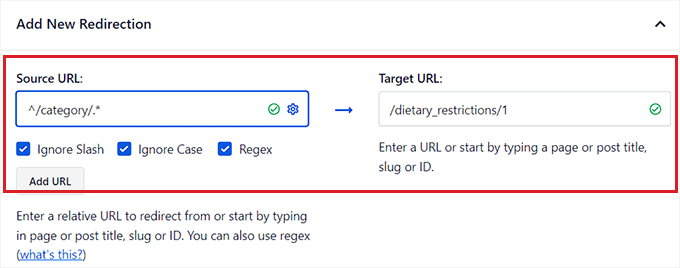
Subsequent, be sure that ‘301 Moved Completely’ is chosen because the redirect possibility from the dropdown menu.
Lastly, click on the ‘Add Redirect’ button in the proper nook.

Upon creation, the redirect you created will likely be displayed on the backside of the web page.
From right here, you may at all times toggle the swap to ‘Inactive’ if you wish to disable it.
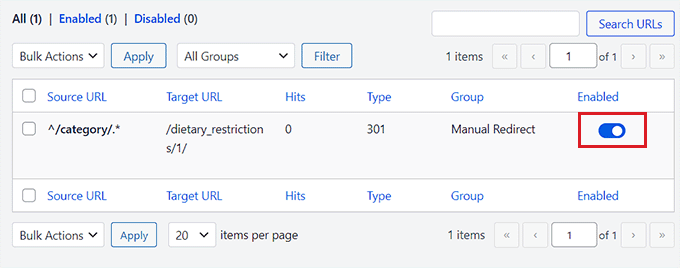
This redirect will now ship all of your class archive visitors to your customized taxonomy.
Nevertheless, we advocate utilizing this methodology provided that you don’t need to use classes in any respect.
If you wish to redirect particular person classes to a customized taxonomy web page, then you could need to see our newbie’s information on establishing redirects in WordPress.
We hope this text helped you learn to convert WordPress classes to customized taxonomies. You might also need to see our information on fashion particular person classes in a different way in WordPress and our professional picks for the perfect conditional logic plugins for WordPress.
In the event you appreciated this text, then please subscribe to our YouTube Channel for WordPress video tutorials. You can even discover us on Twitter and Fb.

